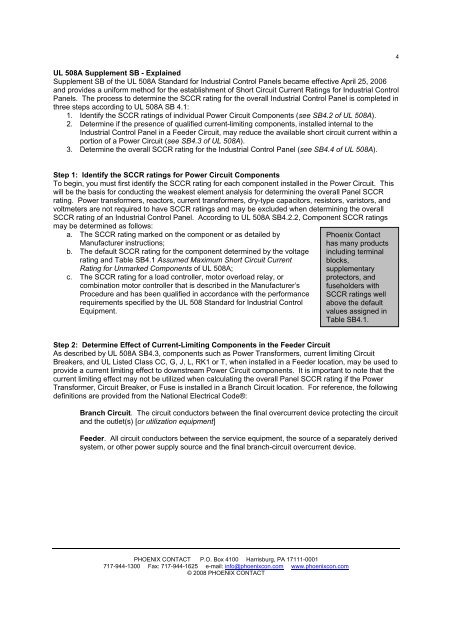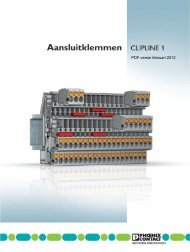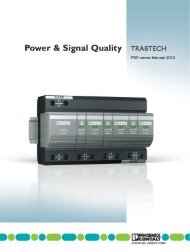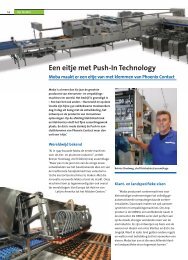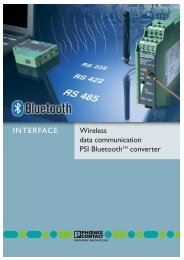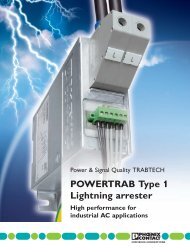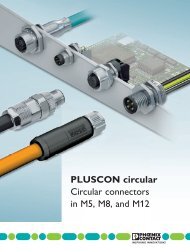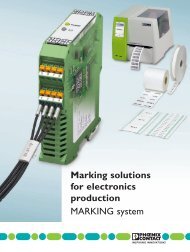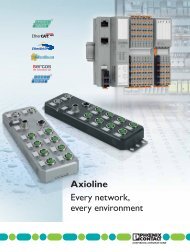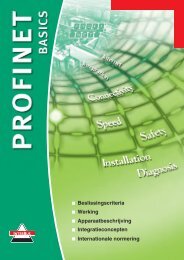Details for "UL 508 A Short Circuit Current Rating" - Phoenix Contact
Details for "UL 508 A Short Circuit Current Rating" - Phoenix Contact
Details for "UL 508 A Short Circuit Current Rating" - Phoenix Contact
- No tags were found...
You also want an ePaper? Increase the reach of your titles
YUMPU automatically turns print PDFs into web optimized ePapers that Google loves.
<strong>UL</strong> <strong>508</strong>A Supplement SB - ExplainedSupplement SB of the <strong>UL</strong> <strong>508</strong>A Standard <strong>for</strong> Industrial Control Panels became effective April 25, 2006and provides a uni<strong>for</strong>m method <strong>for</strong> the establishment of <strong>Short</strong> <strong>Circuit</strong> <strong>Current</strong> Ratings <strong>for</strong> Industrial ControlPanels. The process to determine the SCCR rating <strong>for</strong> the overall Industrial Control Panel is completed inthree steps according to <strong>UL</strong> <strong>508</strong>A SB 4.1:1. Identify the SCCR ratings of individual Power <strong>Circuit</strong> Components (see SB4.2 of <strong>UL</strong> <strong>508</strong>A).2. Determine if the presence of qualified current-limiting components, installed internal to theIndustrial Control Panel in a Feeder <strong>Circuit</strong>, may reduce the available short circuit current within aportion of a Power <strong>Circuit</strong> (see SB4.3 of <strong>UL</strong> <strong>508</strong>A).3. Determine the overall SCCR rating <strong>for</strong> the Industrial Control Panel (see SB4.4 of <strong>UL</strong> <strong>508</strong>A).4Step 1: Identify the SCCR ratings <strong>for</strong> Power <strong>Circuit</strong> ComponentsTo begin, you must first identify the SCCR rating <strong>for</strong> each component installed in the Power <strong>Circuit</strong>. Thiswill be the basis <strong>for</strong> conducting the weakest element analysis <strong>for</strong> determining the overall Panel SCCRrating. Power trans<strong>for</strong>mers, reactors, current trans<strong>for</strong>mers, dry-type capacitors, resistors, varistors, andvoltmeters are not required to have SCCR ratings and may be excluded when determining the overallSCCR rating of an Industrial Control Panel. According to <strong>UL</strong> <strong>508</strong>A SB4.2.2, Component SCCR ratingsmay be determined as follows:a. The SCCR rating marked on the component or as detailed byManufacturer instructions;b. The default SCCR rating <strong>for</strong> the component determined by the voltagerating and Table SB4.1 Assumed Maximum <strong>Short</strong> <strong>Circuit</strong> <strong>Current</strong>Rating <strong>for</strong> Unmarked Components of <strong>UL</strong> <strong>508</strong>A;c. The SCCR rating <strong>for</strong> a load controller, motor overload relay, orcombination motor controller that is described in the Manufacturer’sProcedure and has been qualified in accordance with the per<strong>for</strong>mancerequirements specified by the <strong>UL</strong> <strong>508</strong> Standard <strong>for</strong> Industrial ControlEquipment.<strong>Phoenix</strong> <strong>Contact</strong>has many productsincluding terminalblocks,supplementaryprotectors, andfuseholders withSCCR ratings wellabove the defaultvalues assigned inTable SB4.1.Step 2: Determine Effect of <strong>Current</strong>-Limiting Components in the Feeder <strong>Circuit</strong>As described by <strong>UL</strong> <strong>508</strong>A SB4.3, components such as Power Trans<strong>for</strong>mers, current limiting <strong>Circuit</strong>Breakers, and <strong>UL</strong> Listed Class CC, G, J, L, RK1 or T, when installed in a Feeder location, may be used toprovide a current limiting effect to downstream Power <strong>Circuit</strong> components. It is important to note that thecurrent limiting effect may not be utilized when calculating the overall Panel SCCR rating if the PowerTrans<strong>for</strong>mer, <strong>Circuit</strong> Breaker, or Fuse is installed in a Branch <strong>Circuit</strong> location. For reference, the followingdefinitions are provided from the National Electrical Code®:Branch <strong>Circuit</strong>. The circuit conductors between the final overcurrent device protecting the circuitand the outlet(s) [or utilization equipment]Feeder. All circuit conductors between the service equipment, the source of a separately derivedsystem, or other power supply source and the final branch-circuit overcurrent device.PHOENIX CONTACT P.O. Box 4100 Harrisburg, PA 17111-0001717-944-1300 Fax: 717-944-1625 e-mail: info@phoenixcon.com www.phoenixcon.com© 2008 PHOENIX CONTACT


